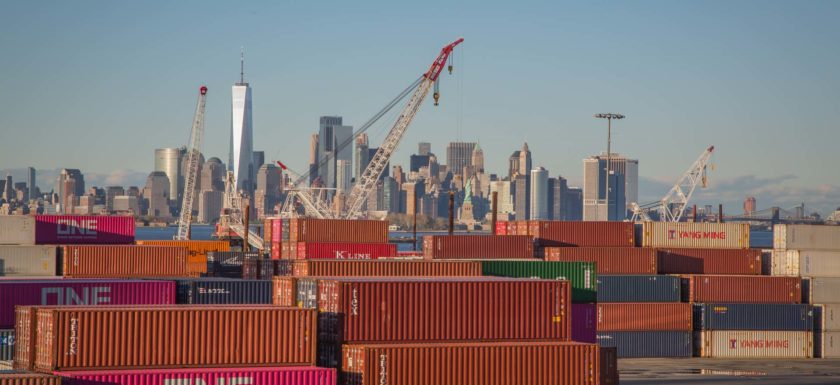Category Archives: Industry News
Long Beach, California, June 28, 2019
The West Coast MTO Agreement (WCMTOA) today announced that on
August 1, 2019, the Traffic Mitigation Fee (TMF) at the Ports of Los Angeles and Long Beach will increase by
1.9 percent. The adjustment matches the combined 1.9 percent increase in longshore wage and assessment rates
that take effect June 29.
Beginning August 1, the TMF will be $32.12 per TEU (twenty-foot equivalent unit) or $64.24 per forty-foot
container. The TMF is charged on non-exempt containers. Containers exempt from the TMF include empty
containers; import cargo or export cargo that transits the Alameda Corridor in a container and is subject to a fee
imposed by the Alameda Corridor Transportation Authority; and transshipment cargo. Empty chassis and bobtail
trucks are also exempt.
The OffPeak program provides regularly scheduled night or S aturday shifts to handle trucks delivering and
picking up containers at the 12 container terminals in the two adjacent ports. PierPass launched the OffPeak
program in 2005 to reduce severe cargo-related congestion and air pollution on local streets and highways
around the Los Angeles and Long Beach ports. Nearly half of all port truck trips now take place during the offpeak
shifts. The container terminal operators mitigate truck traffic at their gates with appointment systems.
The TMF helps offset the cost of operating extended gate hours. Labor costs are the largest single component of
extended gate costs.
According to an analysis by maritime industry consultants SC Analytics, the net costs incurred by the terminals
to operate the off-peak shifts in 2018 totaled $288 million. During that year, the terminals received $217 .5
million from the TMF, offsetting about 76 percent of the OftPeak program’s costs.
About PierPass
PierPass is a not-for-profit company created by marine terminal operators at the Port of Los Angeles and Port of
Long Beach to address multi-terminal issues such as congestion, air quality and security. The West Coast Marine
Terminal Operator Agreement (WCMTOA) is filed with the Federal Maritime Commission, and comprises the
12 international MTOs serving the Los Angeles and Long Beach ports. For more information, please see
Freightways magazine interviewed Gemini Shippers Group COO regarding the impacts of proposed list 4 China tariffs. You can see a copy of the article here,

The Port of New York and New Jersey continued its streak of record-setting months through the first quarter of 2019. In March the Port moved 585,098 TEUs (333,688 lifts) compared to 572,576 TEUs (327,096 lifts) in March of 2018. This number represents a 2.2 percent increase over the record set the previous year, and the most ever recorded for the month of March. The increase brought the year’s cargo total to an all-time record of approximately 1,800,000 TEUs (20-foot equivalent units) during the first quarter of 2019, which represents a 6.7 percent increase over the same period in 2018.
Import loads for the month of March totaled 282,981 TEUs (161,486 lifts), a slight 1.9 percent decrease compared to March of 2018. From January through March 2019, imported loads at the Port of New York and New Jersey reached 905,849 TEUs (515,568 lifts), a 3.9 percent increase over the same period in 2018.
Export loads (TEUs) showed a small decline, dropping 1.6 percent compared to the previous year. In March, export loads totaled 130,038 TEUs (72,002 lifts) compared to 132,105 TEUs (73,407 lifts) in March 2018. For the period of January through March 2019, exported loads at the Port of New York and New Jersey reached 355,229 TEUs (196,836 lifts) versus 361,700 TEUs (200,299 lifts) in the same period of 2018, a 1.8 percent decrease.
In March 2019, export empties increased by 13.5 percent, totaling 170,777 TEUs versus 150,438 TEUs in March 2018. During the period of February through March 2019, export empties rose by 19.5 percent totaling 528,472 TEUs versus 442,268 TEUs in the same period of 2018.
Import empties were down, dropping by 23.2 percent for the period of January through March 2019 compared to the same period in 2018.
In March the Port set a record for cargo handled by rail by moving 58,877 containers, up 11.1 percent over the previous record set in March 2018. Rail volume for the period of January through March 2019 rose by 8.2 percent compared to the same period the previous year.
A total of 55,860 autos moved through the Port of New York and New Jersey in March, a 13.5 percent increase over the previous year. Auto volume for the period of January through March 2019 was 4.7 percent greater than in the same period of 2018.
Find the press release here.
The dry season is lowering canal water levels and has caused the Panama Canal Authority to impose a transit draft restriction on the canal’s Neopanamax locks, effective April 30.
This restriction will reduce the draft to 13.41 meters Tropical Fresh Water (TFW).
This means that if a vessel exceeds 13.41 meters TFW, after April 30, they will be required to off-load cargo to be allowed transit.
Standard Draft for Neopanamax Locks: 15.24 meters (50.0 feet) TFW
Draft Restriction Effective April 30th 13.41 meters (44.0 feet) TFW
How This May Impact Members: Draft restrictions could cause carriers to limit the amount of containers they can carry per voyage reducing overall container capacity on the Asia to US East Coast Trade. Carrier may delay or roll cargo due to this capacity reduction, and in a worst case scenario, bookings may be rejected or forced to move on alternate service strings that do not pass through the Panama Canal.
Please contact the Gemini team if you require further information.
|
March 8, 2019
Contact: John K. Decrosta, (202) 523-5911 On March 7, 2019, the White House notified the Federal Maritime Commission that President Donald Trump has designated Michael A. Khouri as Chairman. He had been serving as Acting Chairman since January 2017. Mr. Khouri began his service as an FMC Commissioner in January 2010. “I thank President Trump for his expression of confidence. I believe it reflects support for the great work that the entire FMC team is doing to ensure fair competition and integrity for America’s ocean supply chain.” |
For Immediate Release
LONG BEACH, California – March 3, 2019
Gemini Shippers Group and Seabury Capital’s Maritime Subsidiary Releases a Report with Insights for Carriers and Shippers on How to Navigate the New IMO 2020 Regulation
Gemini Shippers Group , today released a whitepaper, produced in cooperation with Seabury Maritime LLC (“Seabury Maritime”), the global maritime and transportation investment & merchant banking and industry advisory firm, a division of Seabury Capital Group LLC, providing insight and a general overview of the issues related to the implementation of the International Maritime Organization 2020 (“IMO 2020”) regulation on sulfur oxide emission.
With less than ten months before the IMO 2020 regulation on sulfur oxide emission goes into effect Jan 1, 2020 carriers and shippers alike are facing an uncomfortable uncertainty over its potential effects on costs and freight rates as they enter the 2019-2020 trans-Pacific contracting period. The IMO 2020 regulation mandates the reduction of sulfur oxide emission from 3.5 percent m/m to 0.5 percent m/m.
“The 2020 deadline to reduce sulfur oxide emissions is one of the most significant regulations impacting liner shipping in recent memory,” commented Seabury Maritime Vice President Nikos Petrakakos. “With fuel costs already representing more than 50 percent of total operating expenses, the IMO 2020 poses an increase too significant for carriers to absorb and stay operational.”
The whitepaper details that the lack of industry standard for fuel-surcharges computation or a clear picture of the underlying costs for low-sulfur fuel allows participants to only roughly estimate its economic impact. Several factors affecting a carrier’s calculation of the fuel surcharges add complexity, making transparency ever so paramount to building trust on both sides.
Kenneth O’Brien, Chief Operating Officer of Gemini Shippers Group, commented: “Through our collaboration with our partners at Seabury Maritime, we have identified the inherent risks and cost drivers represented by the IMO 2020 regulation. Our desire to add transparency to the issues will help shippers and carriers alike navigate the 2019-2020 contracting season.”
The whitepaper will be presented during The Journal of Commerce’s Trans-Pacific Maritime Conference held March 3-6 in Long Beach, CA. Access the complete document here. For further information on the study or to speak with the team at Gemini Shippers Group or Seabury Maritime to discuss fuel strategies please contact the team at Gemini Shippers Group.
The following terminals will be closed Monday 3/4/2019 due to inclement weather, APMT, Maher Terminal, PNCT, GCT Bayonne, GCT New York, and RHTC Terminal
If your are attending RILA this week come by the Gemini booth # 331 and talk all things supply chain!
The Florida port moved nearly 1.3 TEUs in FY18; Puerto Rican business grew 37 percent.





